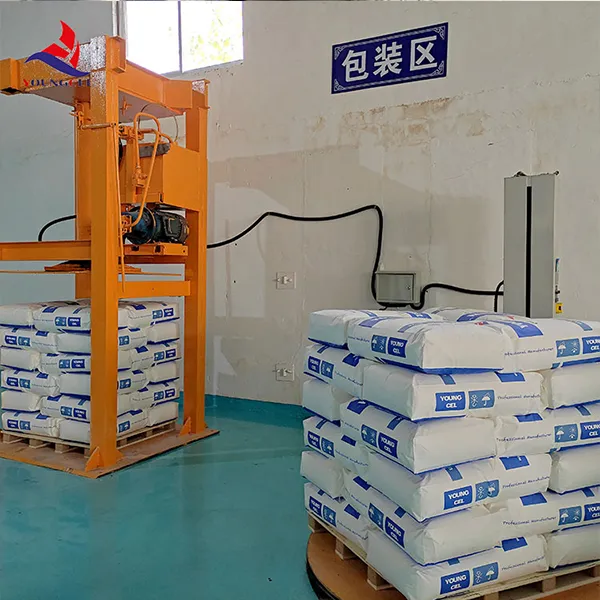Hydroxypropyl Methylcellulose (HPMC) An Overview
Hydroxypropyl methylcellulose (HPMC) is a versatile and widely used polymer derived from cellulose, a natural polymer found in the cell walls of plants. As a non-ionic, water-soluble derivative of cellulose, HPMC has garnered significant attention in various industries including pharmaceuticals, food, cosmetics, and construction. This article aims to provide insights into the properties, applications, and benefits of HPMC.
Chemical Composition and Properties
HPMC is synthesized by modifying cellulose through etherification. In this process, hydroxyl groups of cellulose are substituted with hydroxypropyl and methyl groups. The degree of substitution affects the solubility, viscosity, and other properties of HPMC, allowing for tailored functionalities suitable for different applications. It is available in various grades, each characterized by different viscosity levels and solubility profiles, making it adaptable for specific uses.
One of the most remarkable properties of HPMC is its ability to form gel-like substances when mixed with water. This quality makes it an excellent thickening agent, emulsifier, and stabilizer. Additionally, HPMC exhibits excellent film-forming abilities, which enhance its utility in coatings and drug release systems.
Applications in Various Industries
1. Pharmaceuticals HPMC is widely used in the pharmaceutical industry, primarily as a binder and film-forming agent in tablet formulations. Its controlled release properties make it ideal for sustained-release formulations, allowing for the gradual release of active ingredients over time. Furthermore, HPMC is used in various dosage forms, including capsules, where it enhances bioavailability and stability.
2. Food Industry In the food sector, HPMC serves as a food additive and thickener, improving texture and mouthfeel in products like sauces, dressings, and bakery goods. As a fat replacer, it helps reduce overall calorie content without compromising taste. Importantly, HPMC is considered safe for consumption and has received approval from various food safety authorities.
3. Cosmetics and Personal Care The cosmetic industry utilizes HPMC in the formulation of creams, lotions, and toiletries. Its ability to thicken and stabilize formulations helps create smooth, aesthetically pleasing products. Moreover, HPMC offers a non-greasy feel, making it an attractive option for various skincare formulations.
hydroxypropyl methylcellulose hpmc

4. Construction HPMC is also employed in the construction industry, where it enhances the workability and adhesion of mortar, tile adhesives, and other building materials. Its water-retaining properties help improve the durability of construction mixtures, ensuring better performance and longevity.
Benefits of HPMC
The advantages of using HPMC in various applications are plentiful. Firstly, as a plant-derived product, HPMC is considered non-toxic and hypoallergenic, making it suitable for sensitive applications, especially in pharmaceuticals and cosmetics.
Secondly, its versatility allows formulators to alter its properties to meet specific requirements, such as viscosity, gel strength, and solubility
. This adaptability is crucial in developing innovative products.Additionally, the water-solubility of HPMC simplifies its incorporation into formulations, whether in a dry or wet form. The ease of use streamlines the manufacturing process, ultimately reducing costs and improving efficiency.
Environmental Considerations
With the growing emphasis on sustainability, HPMC stands out as an eco-friendly solution. Being derived from cellulose, a renewable resource, its production has less environmental impact compared to synthetic polymers. Moreover, HPMC is biodegradable, contributing to reduced waste in landfills compared to traditional plastics.
Conclusion
Hydroxypropyl methylcellulose (HPMC) is a multifunctional polymer with broad applications across various industries. Its unique properties, including water solubility, thickening capability, and film-forming ability, make it indispensable in pharmaceuticals, food, cosmetics, and construction. As industries continue to seek out safe and effective ingredients, HPMC presents a compelling choice due to its natural origins and versatility. Looking ahead, further research and development could expand its applications, reinforcing its importance in sustainable product formulations.
-
The Application and Significance of Construction RdpNewsMay.19,2025
-
Industrial Grade HpmcNewsMay.19,2025
-
Building Coating Adhesive Building Coating Adhesive HpmcNewsMay.19,2025
-
Application Of Hpmc For Detergent For Detergent In DetergentsNewsMay.19,2025
-
Application Of Hpmc Cellulose In Cement-Based MaterialsNewsMay.19,2025
-
Application Of High Quality Hpmc For Construction In The Field Of ConstructionNewsMay.19,2025




